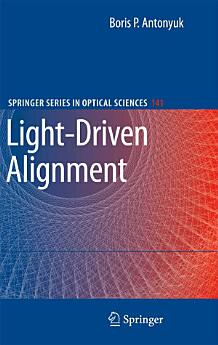Light-Driven Alignment
ছেপ্তে ২০০৮ · Springer Series in Optical Sciences কিতাপ 141 · Springer
৫.০star
১ টা পৰ্যালোচনাreport
ইবুক
244
পৃষ্ঠা
reportমূল্যাংকন আৰু পৰ্যালোচনা সত্যাপন কৰা হোৱা নাই অধিক জানক
এই ইবুকখনৰ বিষয়ে
This book discusses how, in random media, light dramatically changes electron– electron interaction. Despite Coulomb repulsion, the effective interaction dem- strates attraction, even under strong pumping. Light (both coherent and natural) acts like an optical motor, transporting electrons in a direction opposite to that of the electric force direction: electric current ?ows against bias and static polarization is aligned in opposition to the applied electric ?eld. The uncommon electron transport increases the initial perturbations and is the foundation of the light-driven struct- ing of a matter. This structuring belongs to the class of self-organization phenomena of open dissipative systems and exhibits a number of fascinating properties. Light pushes electrons into spatially ordered macroscopic bunches observed in fused silica under ArF-laser irradiation. It carves material balls with ?xed diameters equal to 2 microns and throws them out of the ablation crater. Moderate light int- sity drills material, forming long channels that align with the wave vector and drill diameters can be as small as 2 microns, while the beam spot is a few millimeters. Bicolor excitation causes orientational ordering in random media. We monitored the induced transformation by measuring the emerged second harmonic signal. The orientational ordering has been used for all optical poling of glasses. Light tre- ment prepares phase-matched grating of second-order nonlinear susceptibility and provides effective second harmonic generation. All optical poling was performed in bulk materials and ?bers.
মূল্যাংকন আৰু পৰ্যালোচনাসমূহ
৫.০
১ টা পৰ্যালোচনা
এই ইবুকখনক মূল্যাংকন কৰক
আমাক আপোনাৰ মতামত জনাওক।
পঢ়াৰ নির্দেশাৱলী
স্মাৰ্টফ’ন আৰু টেবলেট
Android আৰু iPad/iPhoneৰ বাবে Google Play Books এপটো ইনষ্টল কৰক। ই স্বয়ংক্রিয়ভাৱে আপোনাৰ একাউণ্টৰ সৈতে ছিংক হয় আৰু আপুনি য'তে নাথাকক ত'তেই কোনো অডিঅ'বুক অনলাইন বা অফলাইনত শুনিবলৈ সুবিধা দিয়ে।
লেপটপ আৰু কম্পিউটাৰ
আপুনি কম্পিউটাৰৰ ৱেব ব্রাউজাৰ ব্যৱহাৰ কৰি Google Playত কিনা অডিঅ'বুকসমূহ শুনিব পাৰে।
ই-ৰীডাৰ আৰু অন্য ডিভাইচ
Kobo eReadersৰ দৰে ই-চিয়াঁহীৰ ডিভাইচসমূহত পঢ়িবলৈ, আপুনি এটা ফাইল ডাউনল’ড কৰি সেইটো আপোনাৰ ডিভাইচলৈ স্থানান্তৰণ কৰিব লাগিব। সমৰ্থিত ই-ৰিডাৰলৈ ফাইলটো কেনেকৈ স্থানান্তৰ কৰিব জানিবলৈ সহায় কেন্দ্ৰত থকা সবিশেষ নিৰ্দেশাৱলী চাওক।







